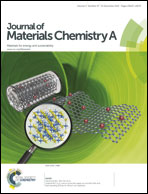Pushing efficiency limits for semitransparent perovskite solar cells†
Abstract
While perovskite-based semitransparent solar cells deliver competitive levels of transparency and efficiency to be envisioned for urban infrastructures, the complexity and sensitivity of their processing conditions remain challenging. Here, we introduce two robust protocols for the processing of sub-100 nm perovskite films, allowing fine-tuning of the active layer without compromising the crystallinity and quality of the semiconductor. Specifically, we demonstrate that a method based on solvent-induced crystallization with a rapid drying step affords perovskite solar cells with 37% average visible transmittance (AVT) and 7.8% PCE. This process enhances crystallization with a preferential phase orientation presumably at the interface, yielding a high fill factor of 72.3%. The second method is based on a solvent–solvent extraction protocol, enabling active layer films as thin as 40 nm and featuring room-temperature crystallization in an ambient environment on a few second time span. As a result, we demonstrate a maximum AVT of 46% with an efficiency of 3.6%, which is the highest combination of efficiency and transparency for a full device stack to date. By combining the two methods presented here we cover a broad range of thicknesses vs. transparency values and confirm that solvent-induced crystallization represents a powerful processing strategy toward high-efficiency semitransparent solar cells. Optical simulations support our experimental findings and provide a global perspective of the opportunities and limitations of semitransparent perovskite photovoltaic devices.



 Please wait while we load your content...
Please wait while we load your content...